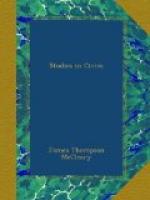Folk-Moot.—Still another common way for two boys to decide a question about which they differ is to “leave it to the boys,” some of whom are knowing to the facts and others not. Each of the disputants tells his story, subject to more or less interruption, and calls upon other boys to corroborate his statements. The assembled company then decides the matter, “renders its verdict,” and if necessary carries it into execution. In this procedure the boys are re-enacting the scenes of the Folk-moot or town meeting of our Saxon ancestors.
Boy-Courts.—Let us look at this boy-court again to discover its principal elements.
In the first place, we see that every boy in the crowd feels that he has a right to assist in arriving at the decision, that “the boys” collectively are to settle the matter. In other words, that the establishment of justice is a public trust. So our Saxon forefathers used to come together in the Folk-moot and as a body decide differences between man and man. The boys have no special persons to perform special duties; that is, no court officers. Neither, at first, did those old Saxons.
Secondly, in the boy-court the facts in the case are brought out by means of witnesses. So it was in the Folk-moot, and so it is in most civilized countries today. Among those old Saxons the custom grew up of allowing the facts in the case to be determined by twelve men of the neighborhood, who were most intimately acquainted with those facts. When they came over to England these Saxons brought this custom with them, and from it has been developed the Trial by Jury. The colonists of this country, most of whom came from England, brought with them this important element in the establishment of justice, and it is found today in nearly all the states.
Again, when in the boy-court the facts of the case have been established and it becomes necessary to apply the rules of the game to the particular case, the boys frequently, invariably in difficult cases, turn to some boy or boys known to be well versed in the principles of the game, and defer to his or their opinion. And, similarly, in the Folk-moot, much deference was paid in rendering judgment to the old men who for many years had helped to render justice, and who, in consequence, had much knowledge of the customs, unwritten laws, in accordance with which decisions were rendered. In this deference to one or more persons who are recognized as understanding the principles involved in the case, we see the germ of judgeship in our present courts.
And finally, a boy naturally reserves the right, mentally or avowedly, of appealing from the decision of the boys to the teacher or his father, in case he feels that he has been unjustly dealt with.
Thus we see that the principal elements of the courts of today, the establishment of justice as a public trust, the determination of the facts by means of witnesses and a jury, the application of the law by one or more judges, the right of appeal to a higher court, are not artificial, but in the nature of things. We inherited them from our primitive ancestors, and in that sense they may be said to have been imposed upon us. But their naturalness appears in the fact that boys when left to themselves introduce the same elements into their boy-courts.




